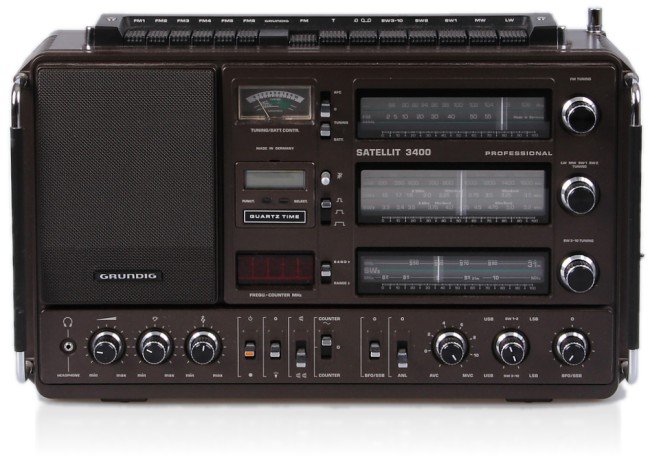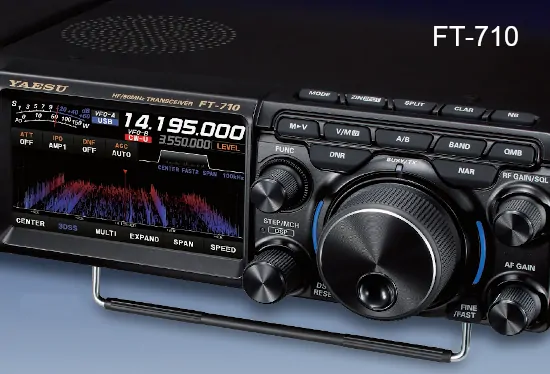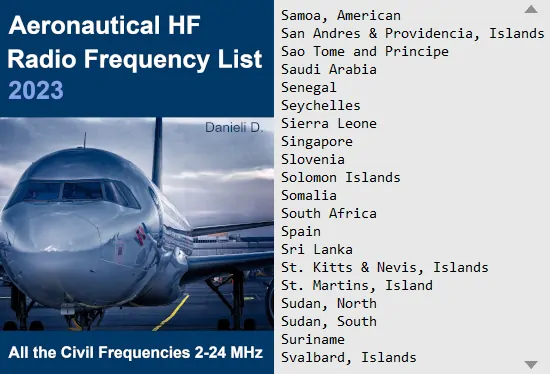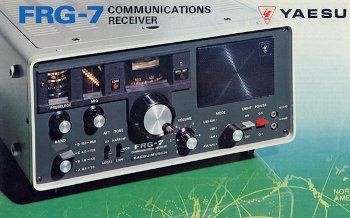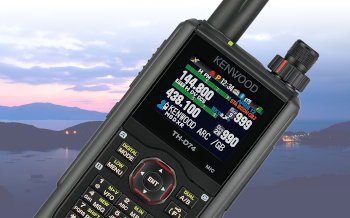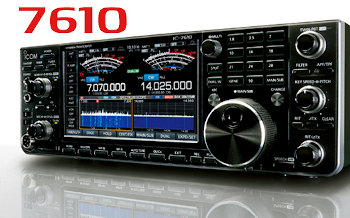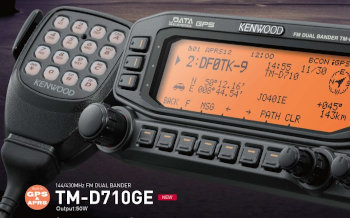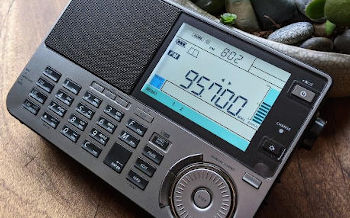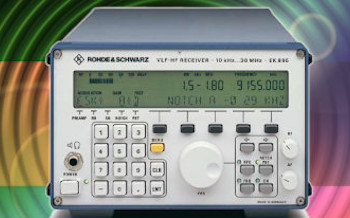S450DLX
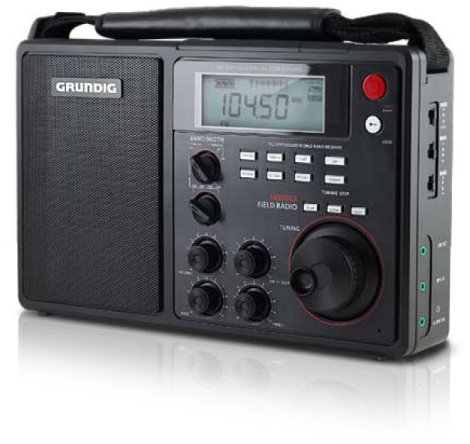
Portable world receiver with FM-Stereo, Medium Wave, Short Wave 1.7~30 MHz in three adjacent bands. Double-conversion super heterodyne with selectable IF bandwidth, also IF output for accessories as DRM converter. Ideated in Germany / R.P. of China.
Reference market : consumer
S450DLX specifications
| General |
| Frequency coverage | |
|---|---|
| 0.5200 ~ 1.7100 MHz (MW) [1]
1.7110 ~ 29.9990 MHz (SW) [2] 87.0000 ~ 108.0000 MHz |
|
| Mode | |
| AM / WFM | |
| Tuning step | |
| 9 / 10 KHz [3] 1 KHz [4] |
| Receiver |
| RF attenuator | |
|---|---|
| Local / DX [5] |
| Features |
| Memory | |
|---|---|
| 10 regular memories for MW
30 regular memories for SW 10 regular memories for FM |
|
| Display | |
| 1 KHz frequency resolution 5-segments signal meter bar |
|
| Power supply | |
| 4.8~6V batteries (4 x AA)
8 VDC external, AC power adapter |
|
| Connections | |
| 9V batteries (6 x D)
9 VDC external, AC power adapter |
|
| Connections | |
| Jack 3.5 mm (headphone)
Jack 3.5 mm (audio line input) Jack 3.5 mm (audio line output) F 50Ω (SW and FM external antenna) Terminal jack 500Ω (MW external antenna) F (IF output) Plug 5.5/2.1 mm (VDC external) |
| Mechanical and environmental data |
| Dimensions | |
|---|---|
| 310 (W) x 195 (H) x 100 (D) mm | |
| Weight | |
| 1.63kg |
- Frequency coverage 0.522~1.620 MHz for 9 KHz steps.
- In three adjacent bands of 1.711~10, 10~20, 20~30 MHz.
- MW band, fast tuning mode.
- SW band, slow tuning mode.
- On MW and SW bands.
The Grundig S450DLX covers without gaps the 0.52 ~ 30 MHz spectrum using a double frequency conversion scheme. In general terms, the receiver is suitable both for the home environment, as an FM tuner with excellent audio quality, and for the indor / portable listening of AM broadcasters. Separate banks of 10 memories allow you to keep track of the favorite frequencies for each band. For medium waves the tuning can be chosen between the 9 or 10 KHz step while there are two options (fast / slow) on the tuning resolution. For MW the radio integrates a ferrite antenna while for the SW and FM there is a telescopic antenna, two connectors then allow the use of external antennas of various types.
S450DLX Other features :
Narrow or wide filter selectivity in AM, continuous RF-gain regulation, front-end selection of local or DX sensitivity, internal or external antenna switching, high and low audio tone control, quick-tune function to recall the memories with a button, clock, double alarm, sleep timer for automatic switch-off programmable between 1 ~ 90 minutes, keypad lock function, use of batteries type D (torch) for a great autonomy, status indicator for the batteries, audio line in/out connections.
The receiver is distinguished by the availability on a special connector on the rear panel for the output of intermediate frequency (IF) signal relative to the AM section between 0.52 ~ 30 MHz. This output can be used to connect accessories that make it possible to process and decode emissions in DRM, SSB, etc.
S450DLX performance and practical notes :
The Grundig S450DLX project is partly derived from C.Crane's CCRadio-SW model, but there are differences between the two versions at the electrical level as well as in the controls. The audio, thanks also to the generously sized loudspeaker, returns a quality sound both in the FM band listening and in the reception of the medium and short wave stations, the availability of the independent bass / treble controls combined with the possibility to select a IF wide filter in AM allows in fact to adapt the audio according to the operator's preferences. The sensitivity is decidedly on good levels in the whole tuning range with an intermodulation resistance superior to many other receivers of the same category. Therefore, it is possible to use the S450-DLX as a DX radio that takes advantage of a very interesting price / performance ratio. To mention the particular detail of the tuning knob, this has in fact a finger rest that makes it comfortable to act on the reception frequency even within extended periods of time - a typical practice for those who seek listening to distant broadcasters.
S450DLX price
We have collected for your convenience the Grundig S450-DLX sale price (US Dollar) and its trend over time. Useful to guarantee a cheaper purchase of this radio and to put it for sale in the second-hand market. Of course offers, accessories, warranty terms and conditions can lead to different figures.
|
|
|
|
| USD 239.00 | 2021-oct |
Second Hand Very good condition |
| USD 299.00 | 2018-nov | Brand-new |
| USD 164.00 | 2018-nov |
Second Hand Very good working and cosmetic condition. Comes with a good set of 6 batteries and shoulder strap |
S450DLX review
| Sensitivity | |
| Selectivity | |
| Dynamic range | |
| Spurious response | |
| Audio | |
| Signal functions | |
| Control functions | |
| User friendly | |
| Stars: 1=insufficient | 2=just sufficient | 3=mediocre | 4=good | 5=excellent | |
Your opinion on merits, defects, experiences, with this radio set is welcome. Write your review, after a technical evaluation by our staff if found suitable will be published on this page. We thank you for your precious contribution.
S450DLX manual
The Grundig S450 manual that we report on this page has a separate elaboration from the official documentation that accompanies the radio, text and images do not violate manufacturer and importers copyrights.
Batteries
Use six "D" size alkaline batteries. The battery compartment is on the back of the radio, remove it by pressing the two tabs and pulling up. Install them with correct polarity using the diagram inside the compartment. Replace them if the battery strength indicator in the display shows only one bar or the audio becomes distorted. The radio will turn off automatically if the batteries become too weak. Note, install only alkaline cells of the same brand and type. To prevent battery leakage never install or replace with batteries of different brands and never intermix old batteries with new ones. When not using the radio for more than ~30 days remove the batteries. Note, if batteries are in the unit and it is powered via its AC adapter it will automatically switch to battery use if there is an AC power failure.
Battery level indicator
The battery level indicator is in the upper left corner of the display. When batteries are full the follow symbol will be displayed in the LCD, if flashes it indicates that batteries are low and the radio will soon turn off automatically.
Left: batteries full | Right: batteries low
AC / DC external power
Plug AC adapter into the socket on the left side of the radio. When the adapter is plugged in the full power level will show in the upper left corner of the display, looking like a full battery as above image. If you lose the AC adapter that came with the radio use one with 9V / 0.5A DC output, negative polarity, and a plug with 5.5 millimeter outer diameter, 2.1 millimeter inner diameter.
Turning the radio ON and OFF
Turn on the radio by pressing the red "POWER & SLEEP" button on the front top right corner of the radio. When the unit is on, press the "POWER & SLEEP" again to turn the radio off.
Sleep timer
Turn on the radio by pressing the red "POWER & SLEEP" button as above. When it turns on you will briefly see a sleep timer symbol in the bottom portion of the display, this is the sleep time and the radio will play for this amount of minutes and then shut-off.
Sleep timer symbol
It can be deactivated by continuously pressing the power button until "on" appears in the bottom of the display, with each press you will see the numbers going down from 90 to 60 > 45 > 30 > 15 > 10 > 5 > 1 minute and then to "on". When "on" appears stop pressing the button. The sleep timer is now disengaged and you don't have to change it unless you want a sleep time to appear. To activate the sleep timer, turn the radio on and press the "POWER & SLEEP" button continuously until the desired sleep time appears. The radio will play for the specified length of time and automatically shut off.
Lock function
To lock all of the keys and buttons press and hold the "LOCK" button, on front top of the radio, until you see a symbol of a key appear in the top, middle of the display. Press the same button for 2 seconds to unlock it.
Lock symbol
Tuning
Tuning knob controls
Above the tuning knob are the "STOP", "SLOW" and "FAST" buttons. Pressing "STOP" locks the tuning dial. Press it again to unlock it. Pressing "SLOW" or "FAST" gives you slow tuning or fast tuning. Use which ever one that you prefer. To quickly tune across a band press the "Q.TUNE" button, below the display. It will save you time when going to a frequency on the other end of the band. This works on AM, FM and Shortwave bands.
Tuning FM
First fully extend the telescopic antenna and turn on the radio. Place the top "BANDWIDTH" control onto the "MONO" or "STEREO" position. Stereo is needed only when you're using headphones and "STEREO" appears above the top left of the frequency in the display. FM mono has better signal to noise ratio as well as anti-multiplex interference. Tune in the station with the "Tuning knob" or by pressing the "UP/DOWN" button or by pressing and holding the "UP/DOWN" button for one second to engage auto tuning.
Tuning MW
Medium wave stations range on 520-1710 KHz in North America and on 522-1620 KHz in Europe and other parts of the world. In North America they tune in 10 KHz steps and in other parts of the world they may tune in 9 KHz steps. The radio is set up for 10 KHz tuning by default, to change the steps to 9 KHz go into the battery compartment (remove it by pressing the two tabs and pulling up) and move the switch from 10 KHz to 9 KHz and then press the reset button (in the front lower right of the radio) with a paper clip. The switch is located on the middle of the ridge between the upper set and lower set of batteries.
Tune in the station with the TUNING knob or by pressing the "UP/DOWN" button or by pressing and holding the "UP/DOWN" button for one second to engage auto tuning. Place the top "BANDWIDTH" control onto the "WIDE" or "NARROW" position. Use "WIDE" if no interference is present. Use "NARROW" if interference is present, the "NARROW" cut highest audio frequencies.
Tuning SW
Short wave range on 1711-29999 KHz. Place the lower switch into "SW1" (1711-9999 KHz), "SW2" (10000-19999 KHz) or "SW3" (20000-29999 KHz) sub-band. Place "RF GAIN" control into the 10 position, decrease if necessary. Tune in the station with the TUNING knob or by pressing the "UP/DOWN" button or by pressing and holding the "UP/DOWN" button for one second to engage auto tuning.
Memories
Storing and retrieving into / from presets
Tune to the station that you want to store. Press and release the "T.SET" button and see "Preset" with a number underneath it flash in the right side of the display. Press the "UP" or "DOWN" buttons over and over to find the "Preset" number that you want to store it into. A quick press of the "T.SET" button will finalize the entry. Press the "PRESET" button continuously to retrieve the stations that have been stored. Notice that the frequency in the display changes and the "Preset" number shows on the right side of the display. Note, a station cannot be erased from memory. Simply store another station over it.
Clock
Setting the clock
The radio's clock works in either the 12h or 24h mode. To change the clock from one mode to another turn the radio off, press and hold the "UP" button for 5 seconds. With radio off press and hold the "T.SET" button until the hour starts flashing. Turn the tuning knob in either direction or press the "UP" button to set the hour. Quick press the "DOWN" button to make the minutes flash and turn the tuning knob to set the minutes. Quick press the "T.SET" button to finalize the entry. Do the above steps quickly or the time set mode will exit.
Setting the alarm
On the radio there are two alarm clocks, Timer "A" and Timer "B". Turn the radio off and press and hold the "TIMER A" or "TIMER B" button until the hour flashes. Turn the tuning knob in either direction or press the "UP" button to set the hour. Quick press the "DOWN" button to make the minutes flash and turn the tuning knob to set the minutes. Quick press whichever button you are using, "TIMER A" or "TIMER B", to finalize entry. For activating and deactivating the alarm clock press and release the "TIMER A" or "TIMER B" button. "Timer A" or "Timer B" flashes in the display. While it flashes, press "ALARM" over and over. A bell symbol, speaker symbol or nothing appears in the display next to "Timer A" or "Timer B".
Left: bell symbol | Right: speaker symbol
Select the bell icon to activate the alarm and set the alarm to go off with a beeping sound. Select the speaker icon if you wish to wake up to the last radio station tuned to. If nothing is selected the alarm will be deactivated. Note, set the volume to a level you want to hear.
Snooze function
To delay the alarm the snooze feature can be activated by pressing the "SNOOZE" button, top right of radio, when the alarm turns on. Once pressed the alarm will activate again in 5 minutes. This can be repeated up to 4 times in all.
Line IN/OUT
These two sockets are on the right side of the radio, an 3.5 mm (1/8-inch) stereo type. An external audio device can be played by connecting an AUX line from the device into the Line-In socket. The Line-Out socket can be used to feed audio from the radio to amplified external speakers.
Earphone jack
The earphone jack can be used with stereo headphones using an 3.5 mm (1/8-inch) plug. FM sound is in stereo if the signal is transmitted in stereo and the "ST" position is selected with the "BANDWIDTH" switch.
Antenna connections
Antenna switch
Use this switch, right side of radio, to enable the use of internal or external antennas.
External antenna
The "FM/SW EXT.ANT" socket, on the back of the radio, is for FM and SW antennas designed to be fed with 50 or 75 ohm coaxial cable, primarily as dipoles - It can also be used for SW long wire antennas. The "MW EXT.ANT" socket is a 500 ohm impedance socket for use with long wire Medium Wave antennas. Note, for improved AM performance use the GRUNDIG AN200 Medium Wave broadcast band loop antenna (not included) or any similar model. These does not need to be plugged in, simply set it next to the radio and tune it to the same frequency that the radio is tuned to. Swivel the radio and the antenna to achieve maximum performance.
IF connection
AM IF output
Use this socket, back of radio, to access an amplitude modulated intermediate frequency (IF) output for use in receiving DRM signals. It can also be used for other types of radio frequency experimentation. To find out more about it, enter "455KHz intermediate frequency output to PC" on an internet search site.
Other
DX/LOCAL switch
If the station you're listening to is so strong that it sounds distorted turn this switch, right side of radio, to the "LOCAL" position. Otherwise, leave it on "DX" which stands for maximum sensitivity.
RF Gain knob
When listening to AM (Medium Wave) broadcast band or SW (Short Wave) bands, this control knob should be dialed to or near position ~5. If you are listening to a weak station, increase the gain, when listening to extremely strong stations, decrease the gain. For listening to shortwave stations place at the beginning this control to maximum gain and decrease as necessary.
Bass/Treble knobs
Use these knobs, lower of four knobs on front center of radio, to control the bass and treble audio response of the radio's speaker system.
Light button
Press this button, right top of the radio, to light the display for a few seconds. When using the AC adapter pressing it for 3 seconds will permanently light the display.
Light switch
Flip this switch, right side of the radio, to "ON" to make the keys light when they are pressed. Flip it to "OFF" to turn off this feature.
Reset
If the radio malfunctions or doesn't work properly reset all electronics system. Insert a paper clip into the hole on the front lower right side, make sure the paper clip is inserted until the display reappears.
